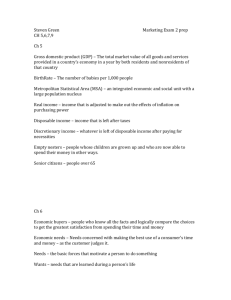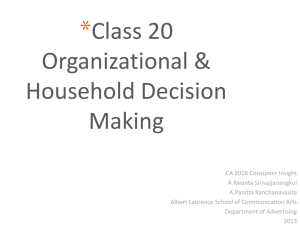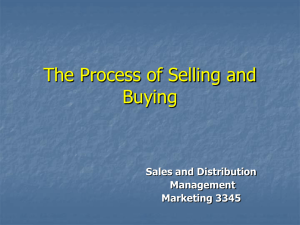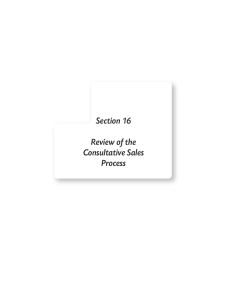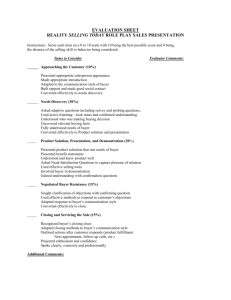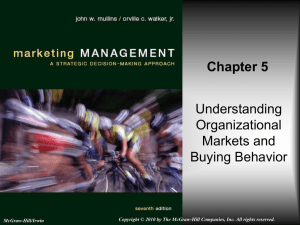Opportunity Analysis, Market Segmentation & Market Targeting
advertisement
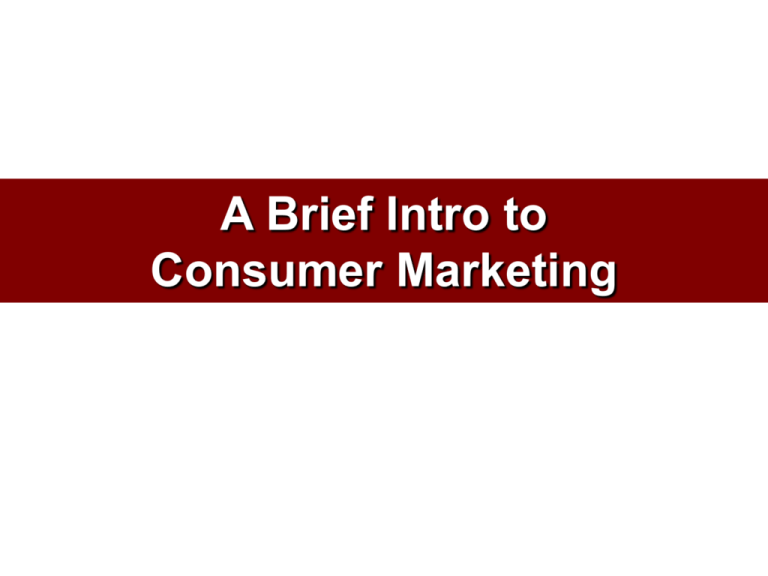
A Brief Intro to Consumer Marketing A Model of Buyer Behavior Other Stimuli Marketing Economic Stimuli Technology The Four P’s Political Cultural Buyer’s Characteristics Buyer’s Decisions Product choice Brand choice Dealer choice Purchase timing Purchase amount Buyer’s Decision Process Buyer’s Characteristics - Cultural • Culture – most fundamental determinant of a person’s wants and behavior. • Subculture – nationalities, religions, racial groups, and geographical regions. • Social Class – income, occupation, education, & area of residence. Buyer’s Characteristics - Social • Reference Groups – all groups having a direct or indirect influence on person’s attitudes or behavior. • Family – single most important consumer-buying organization in society – family of orientation vs. family of procreation. • Roles & Statuses Buyer’s Characteristics - Personal • Age & Life Cycle Stage • Occupation • Economic Circumstances • Lifestyle • Personality & Self-Concept Buyer’s Characteristics Psychological Motivation • Biogenic needs – needs arising from physiological states of tension such as hunger, thirst, discomfort. • Psychogenic needs – needs arising from psychological states of tension such as the need for recognition, esteem, or belonging. Buyer’s Characteristics Psychological Perception • The process by which an individual selects, organizes, and interprets information inputs to create a meaningful picture of the world. • Types of Selective Perception: – Selective Attention – Selective Distortion – Selective Retention Buyer’s Characteristics Psychological • Learning – changes in an individual’s behavior arising from experience. • Beliefs – descriptive thoughts that a person holds about some object/issue. • Attitudes – relatively enduring un/favorable evaluations, emotional feelings, and action tendencies toward some object/issue. Psychographics According to VALS • VALS: Values and Lifestyles Framework. • Intended to yield insights into: – why people believe/behave as they do, and – how internal values & attitudes are expressed externally. • Primarily based upon consumers’ orientations and level of resources. VALS Higher Resources Groups • Actualizers – successful, sophisticated, active, “take-charge” types – cultivated tastes for upscale, niche-oriented products – generally status-oriented • Achievers – successful, career/work oriented – prefer established, prestige products to impress peers – status-oriented VALS Higher Resources Groups • Fulfilleds – mature, satisfied, comfortable, reflective – prefer durability, functionality, & value in products – principle oriented • Experiencers – young, enthusiastic, impulsive, rebellious – high proportion of income spent on clothing, fast food, music, movies, & video. – Action oriented VALS Lower Resources Groups • Believers – conservative, conventional, traditional – favor familiar products & established brands – principle oriented • Strivers – uncertain, insecure, approval-seeking – prefer stylish products to emulate purchases of those with greater resources – status oriented VALS Lower Resources Groups • Makers – practical, self-sufficient, traditional, family-oriented. – Prefer practical, functional products – action oriented • Strugglers – typically elderly, resigned, passive, concerned – cautious consumers who are loyal to favorite brands – status oriented Types of Buying Behavior • Significant Differences Between Brands – High involvement: complex buying behavior – Low involvement: variety-seeking buying behavior • Few Differences Between Brands – High involvement: dissonance-reducing behavior – Low involvement: habitual buying behavior Consumer Purchase Decision Process 1. Problem Recognition 2. Information Search 3. Evaluation of Alternatives 4. Purchase Decision 5. Postpurchase Behavior A Brief Intro Business-to-Business (B2B) Marketing What Is Business Marketing? • Those activities that facilitate exchanges involving products and customers in business markets • A business transaction between – a professional seller (representing a selling company) and – a professional buyer (representing a buying company) • Activities in which goods or services are sold for any use other than personal consumption • Note: It is not the nature of the product; it is the nature of the transaction. B2B versus B2C Marketing Characteristic B2B Market B2C Market Sales volume Greater Smaller Purchase volume Greater Smaller Number of buyers Fewer Many Size of individual buyers Larger Smaller Location of buyers Concentrated Diffuse Buyer-seller relationship Closer More Impersonal Nature of channel More direct Less direct Buying influences Multiple Single/Multiple Type of negotiations More complex Simpler Use of reciprocity Yes No Use of leasing Greater Less Key promotion method Personal Selling Advertising Characteristics of Business Demand • • • • Derived Demand Inelastic Demand Fluctuating Demand Joint Demand –“Derived demand” says that demand for a business product is linked to demand for a consumer good. • This means consumer demand affects business marketing up a vast network of channels. Classifying Business Goods & Services 3 Main Categories of Products Entering Goods Become part of the finished product Cost assigned to the manufacturing process Foundation Goods Capital Items Typically depreciated over time Facilitating Products Support organizational operations Handled as overhead expenses Classifying Business Goods & Services Entering Goods Raw Materials Farm products & natural products Only processed as necessary for handling & transport Require extensive processing Manufactured Materials & Parts Any product that has undergone extensive processing prior to purchase Component Materials require additional processing Component Parts generally do not require additional processing Classifying Business Goods & Services Foundation Goods Installations Major long-term investment items Buildings, land, fixed equipment, etc. Accessory Equipment Less expensive & short-lived Not considered part of fixed plant Portable tools, PC’s, etc. Classifying Business Goods & Services Facilitating Products Supplies Any supplies necessary to maintain the organization’s operations Services Maintenance & Repair support Advisory support Logistical support Categories of B2B Customers • Commercial enterprises –Indirect channel members and facilitators –OEMs (original equipment manufacturers) –Users = customers • Governmental organizations • Institutions Major Uses of B2B Products For additional production (e.g., components are combined into subassemblies and become part of the finished product) For use in operations, but not part of the finished product For resale Steps in the Business Buying Process 1. 2. 3. 4. 5. 6. 7. Recognizing the need Developing product specifications Soliciting bids from potential suppliers Making the purchase decision Issuing the contract Inspecting delivered goods for quality Evaluating vendor performance Types of Business Buying Situations • New-task buy: – Business buying situation that is new and very different from anything that the buyer has faced previously. • Straight rebuy: – Most common type of business buying situation; buyer purchases a part, material, or service routinely, with little thought going into buying process. • Modified rebuy: – Reevaluation of alternatives; necessary because buying requirements have changed such that relatively routine buy or purchase no longer is routine. Examples of Products Purchased Using the Buy-Class Modified Rebuy Straight Rebuy Office Supplies Pure routine Vehicles Consulting Services Installations Complete negotiation Electrical Components Electricity Gas/Water Bulk Chemicals New Buy Computer Systems Moon Shot Insurance Insurance for the Apollo 11 Moonshot Buygrid Analysis Framework New Buy Modified Rebuy Straight Rebuy Need Recognition Develop Product Specifications Solicit Bids Make Purchase Decision Issue the Contract Inspect Goods for Quality Evaluate Vendor Performance Complexity of Buying Situation Buygrid Analysis Framework New Buy Modified Rebuy Straight Rebuy Need Recognition Develop Product Specifications Solicit Bids Make Purchase Decision Issue the Contract Inspect Goods for Quality Evaluate Vendor Performance Creeping Commitment
